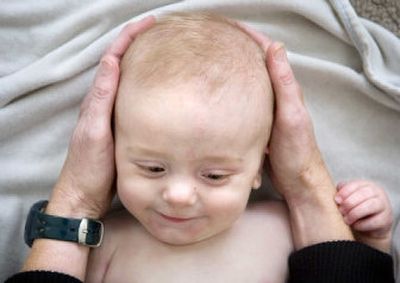Infant massage provides comfort, creates bond between mom, baby

WHEN SHANNON HOLDEN GAVE BIRTH to her son, Noah, six months ago, she was looking for ways to connect with other new moms. What she found was a class that put her more in touch with her baby.
Holden took a class from Kim Harmson, a certified infant massage instructor with a Spokane business called In Touch. Now almost every day, Holden, a pharmacist, gently wrings her son’s legs and rubs his back and chest to not only comfort him, but likely improve his circulation, muscle tone and the organization of the neural network in his brain.
“He calms right down,” Holden said. “Even afterward he’s calm.”
Research done by Tiffany Field, of the Touch Research Institute at the University of Miami School of Medicine, shows that infant massage facilitates the parent-baby bonding process, reduces colic, helps babies sleep, reduces stress in babies during painful procedures like vaccinations and lessens the pain of teething and constipation.
Studies on preterm babies indicate massaged infants gained 47 percent more weight, even when they were give the same amount of calories as babies who weren’t massaged. They were awake and active for a greater percentage of the time, and they performed better on motor activity, behavior and other tests. The preterm infants also were hospitalized, on average, six days fewer than ones who weren’t massaged.
Infant massage, said Harmson, helps mothers, too.
“When you kind of get in that rhythm with your baby, your hormones change and your stress level is reduced,” she said. “I’ve seen it enhance the breastfeeding process.”
Conversely, when mom is stressed, “your baby picks up on that,” she said.
Before Harmson begins a massage, she cradles the baby’s head in her hands, makes eye contact and asks the baby if he wants to begin.
“If the baby is crying, you don’t have permission,” she said.
If the infant is quiet and alert, she runs her hands softly over his body and then rubs an unscented – but not mineral – oil in her hands. This ritual tells the baby what’s coming and often the infant’s face lights up with excitement, she said.
She warned against doing a full-body massage on a newborn; it might over stimulate the young baby. Harmon also said to use firm, gentle pressure.
Last Thursday, Holden’s mother took an infant massage class from Harmson so she could help soothe her grandson when she watches him one day each week. Jane Bonogofski sat on her living room floor in North Spokane with Noah between her legs and gently rubbed the bottom of his feet from the heel to the toes as Harmson demonstrated the massage moves on a doll.
Bonogofski had seen Noah’s response to massages from his mother and wanted to bring the same calm to him her daughter could – even as the stressful world whirled around them.
“You’ve got places to go and things to do, but you can tell they’re just loving it,” she said.
To learn more about Harmson’s classes, visit www.intouchwithyourbaby.com or call (509) 747-7377.
Infant massage is also taught through Community Health Education and Resources, www.cherspokane.org, (509) 232-8138.
State protects kids from smoking
Washington state ranks seventh in the nation in funding programs to prevent children from using tobacco, according to a report by a group of public health organizations.
The state spends $27.2 million a year on tobacco-prevention programs.
That amounts to almost 82 percent of the minimum amount of $33.3 million the U.S. Centers for Disease Control and Prevention recommends states spend. Only four states – Maine, Colorado, Delaware and Mississippi – fund tobacco prevention at the recommended level.
Meanwhile, tobacco companies are spending $184.9 million a year to market cigarettes and other tobacco products in Washington, according to the report.
Despite the disparity in spending, fewer children are smoking in Washington. Since the late 1990s, the smoking rate has dropped 57 percent among sixth-graders, 49 percent among eighth-graders and 44 percent among 12th-graders.
Idaho ranked 36th for spending $1.9 million, or 17 percent of the recommended amount, on tobacco prevention in 2005.
At the bottom of the list are Michigan, Missouri, New Hampshire, South Carolina, Tennessee and Washington, D.C., which allocate no significant state funds to prevent smoking.
The report was compiled by the Campaign for Tobacco-Free Kids, the American Heart Association, the American Cancer Society and the American Lung Association.
Helping strangers in danger
A new study out of Europe says strangers are more likely to help a person in danger if they’re the only witness available or, when there are other witnesses, if the victim is in big trouble.
“Bystander effect,” when no one steps in when a person is endangered, is more likely to occur when more people are watching, the study found.
Researchers monitored the reaction of 54 women and 32 men as they watched the interaction of a male and female actor. The study participants were told that the two had never met.
Within a few minutes, the actors’ interaction turned violent, to a varied degree.
“In situations of low danger, 50 percent of observers tried to help the victim if they were watching alone, but this dropped to 6 percent when a bystander was present,” a release about the study says.
But in situations of high danger, 44 percent of observers alone and 40 percent of those accompanied by someone else helped the victim.
The findings will be published in the latest edition of the European Journal of Social Psychology.
Medicare meeting
Haven’t attended a Medicare Part D information session yet? SHIBA, the volunteer agency that helps the public with insurance issues, is hosting one at 9 a.m. Wednesday at Holy Family Hospital, lower level Room 1.
Medicare Part D is the new prescription drug benefit. Enrollment began Nov. 15 and runs through May 15. After that deadline a penalty will be tacked onto monthly premiums.